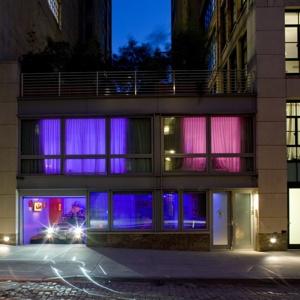This post has been read 3150 times!
Nearby resident, Alan Wilzig, and fan of BatteryPark.TV, is featured in the NY Post today.
Where there’s a Wilzig By MICKI SIEGEL New York Post
Last Updated: 9:06 AM, January 12, 2012 Posted: 9:50 PM, January 11, 2012
There’s no shortage of remarkable residences in tony TriBeCa. But with a Crestron home-automation system that turns a room pink or purple at the touch of a button, a 550-gallon fish tank, a tanning room with a dry-heat sauna, a private garage for motorcycles and even a collection of uranium glass (perfectly safe, we’re assured), Alan Wilzig’s 7,500-square-foot Hubert Street townhouse takes things to another level.
Wilzig, a TriBeCa pioneer, is the founding director of the Jewish Community Project of Lower Manhattan, which was created in 2001 and launched a Jewish preschool. He’s co-owner of the new, red-hot Kutsher’s Tribeca, a “modern Jewish-American bistro” that’s already known for its high-quality smoked meats, latkes and matzo-ball soup. And along with being an entrepreneur, race-car driver and motorcycle enthusiast, Wilzig, 46, has created one of the craziest and most colorful houses in his moneyed neighborhood.
Back in 2003, Wilzig lived in TriBeCa and worked in Jersey City. Every night on the drive home, while exiting the Holland Tunnel, he saw a billboard that intrigued him. “Coming Soon,” it read. “Full-floor penthouse condos, maisonettes, townhouses.”
“I would see that and wonder about condo townhouses,” Wilzig says. “It was as if that sign were there just to entice me.”
It turned out that developers were putting up a building called the Hubert at 7 Hubert St., and two townhouses were part of it. One seemed perfect for Wilzig and his future wife, Karin Koenig. It was a rare, 39-foot-wide, three-story glass house (Wilzig later put in bulletproof windows) sandwiched between two 17-story towers.
This private home had the amenities of a luxury building — a doorman, 24-hour concierge services, a superintendent and tight security. Plus, the townhouse had its own garage. “It was really the best of both worlds,” Wilzig says.
The security-conscious Wilzig especially liked the fact that there are several ways to get into the house. He could drive in through his garage. He could walk in through the house’s French doors on the street. But for Karin, 41 — an artist and high-fashion handbag designer (winisha.com) — he wanted her to enter through the lobby with its watchful doorman and then walk to an inner door of the townhouse.
In addition to its 7,500 square feet inside, the townhouse has a 2,500-square-foot rooftop garden and a 1,000-square-foot backyard patio that houses a hot tub big enough for eight people. The residence has five bedrooms, 5 1/2 bathrooms, an eat-in kitchen, a dining area, an office, a media room, a laundry room and the garage, where the color orange dominates.
There was just one problem — and it was a big one. “The developer wanted to cut the rooftop space in half,” Wilzig says. “That meant I would have 1,250 feet, and another apartment would have the rest for a patio. I said that I wouldn’t buy the townhouse without the entire space. In that case, the builder wanted $300,000 added to the purchase price of $3,335,000.
“It was finally settled when I offered another $100,000 and said the builder could give me an empty concrete box instead of finishing it with marble, wood and fancy appliances. And, that way, Karin and I designed the apartment the way we wanted.”
The renovations took 11 months and cost more than $1.5 million.
The couple were married by the time they settled into the townhouse in November 2005. That December, Karin gave birth to their son, Siggi (named after Wilzig’s late father). Eighteen months later, daughter Winni was born.
The Wilzigs filled the townhouse with unusual household items. First and foremost is the Crestron system that, in addition to changing the lighting, controls the music and the TVs, unlatches the front door and has buttons for everything from checking out the weather to looking in on the children in their rooms to seeing what’s going on in the street around the house.
“Part of the fun of home automation is that I can change the colors of everything from the fish in our aquarium to the façade of our townhouse,” Wilzig says. “When we set this up, I was still planning on lots of entertaining and making the house something like a nightclub. So, the media/ entertainment room, the lower level of the house and the garage can be bathed in different-colored lights.
“The reality is, we moved in here and a month later Siggi was born. So, the first time we turned the color on was to turn the house’s façade baby blue in honor of his birth. And, later, we did it in pink for Winni.” (And, for parties, they can light up the façade of the house to match the occasion.)
Also colorful is the 14-foot-long fish tank that holds a family of butterfly koi. (Wilzig thinks they’re happy because his lighting controls can turn the color of the white fish to red, yellow, blue or whatever mood strikes him.) And a 10-foot-long skylight above the main staircase can be transformed to the color of a pink sunset or the blue of a sunny day.
In the media room, one wall is covered in a material called Screen Goo; it’s a specially formatted line of acrylic paint for video projection that turns the wall into a super-size screen for movies and TV. Then, when it’s not in use, it’s just an ordinary-looking wall.
But the home isn’t just about fun. Wilzig turned the master bedroom into a “safe” room. The door is made of heavyweight steel with unbreakable locks. There’s a peephole with a view of the entire hallway.
“The bed is in reverse,” Wilzig says of the bedroom. “The television is built into the headboard instead of the footboard. That’s because it faces the bath and its glass shower. I find it much more entertaining to watch my beautiful wife take a shower than to watch television.”
But since opening Kutsher’s TriBeCa on nearby Franklin Street in November, there hasn’t been enough time to watch much of anything but the upscale deli.
The restaurant was inspired by the old Kutsher’s Resort Hotel and Country Club in the Catskills and the long friendship of the Wilzigs and the Kutshers. Wilzig’s father was an Auschwitz survivor who ended up controlling banks and oil companies, but vacationed only at Kutsher’s Resort. Today, the sons, Wilzig and Zach Kutsher — with partners Jeffrey Chodorow and Richard Kirshenbaum — are picking up where their fathers left off.
Wilzig is also launching a reality TV show with Lionsgate Entertainment. Its working title is “Wilzig World,” and the plan is to start broadcasting by next fall. With the exception of his sister, Sherry (who Wilzig says is “normal and conservative”), the show will focus on Wilzig’s flamboyant family.
“It will be about everything from my professional racing and what it’s like owning my own racetrack in Columbia County,” Wilzig says, “to the unique lifestyle of my perpetual bachelor brother Ivan, who’s called the king of the Hamptons. He lives in a 15,000-square-foot castle in Water Mill that Karin and I built.”
That castle, which was featured in The Post last June, includes a dungeon that also serves as an eight-car garage.
“And then there’s our mother,” Wilzig continues. “I think it’s safe to say that she’s the only 76-year-old Jewish grandmother who owns 5,000 pieces of erotic art and runs her World Erotic Art Museum in the heart of South Beach.”
But surely, Wilzig’s townhouse, with all its quirks and colorful flourishes, will be one of the stars of the TV show.
“A friend says that I created a bachelor pad for the entire family,” Wilzig says. “That might be. The house looks like a bachelor pad, but it functions like a family home.”

